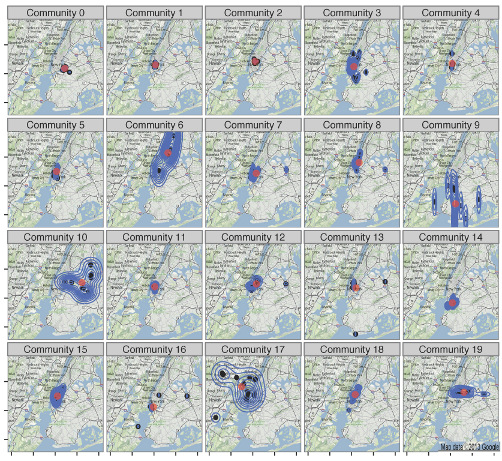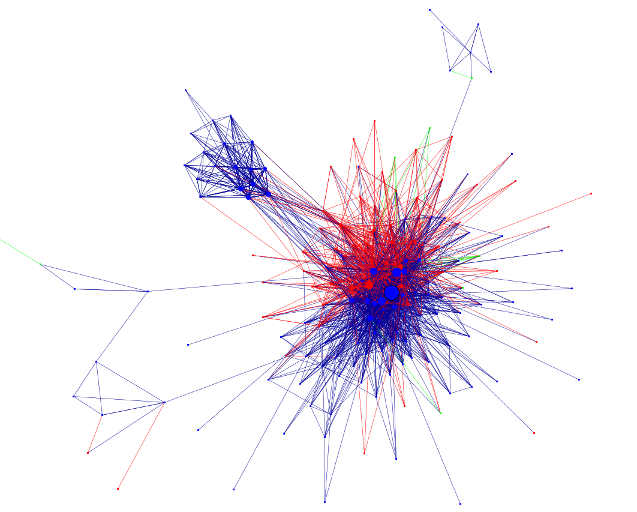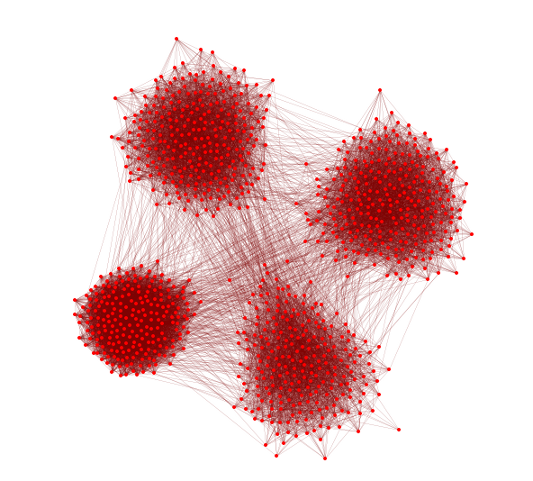Testing social theory with FourSquare data
Overview | People | Collaborators | Sponsors | Publications | Tools
 Joseph, K., Carley, K. M., & Hong, J. I. (2014). Check-ins in 'Blau Space': Applying Blau's Macrosociological Theory to Foursquare Check-ins from New York City. ACM Trans. Intell. Syst. Technol., 5(3), 46:1-46:22. doi:10.1145/2566617
Joseph, K., Carley, K. M., & Hong, J. I. (2014). Check-ins in 'Blau Space': Applying Blau's Macrosociological Theory to Foursquare Check-ins from New York City. ACM Trans. Intell. Syst. Technol., 5(3), 46:1-46:22. doi:10.1145/2566617
Peter Blau was one of the first to define a latent social space and utilize it to provide concrete hypotheses. Blau defines social structure via social 'parameters' (constraints). Actors that are closer together (more homogenous) in this social parameter space are more likely to interact. One of Blau's most important hypotheses resulting from this work was that the consolidation of parameters could lead to isolated social groups. For example, the consolidation of race and income might lead to segregation. In the present work, we use foursquare data from New York city to explore evidence of homogeneity along certain social parameters and consolidation that breeds social isolation in communities of locations checked-in to by similar users.
More specifically, we first test the extent to which communities detected via Latent Dirichlet Allocation are homogenous across a set of four social constraints - racial homophily, income homophily, personal interest homophily and physical space. Using a bootstrapping approach, we find that fourteen (of twenty) communities are statistically, and all but one qualitatively, homogenous along one of these social constraints, showing the relevance of Blau's latent space model in venue communities determined via user check-in behavior. We then consider the extent to which communities with consolidated parameters, those homogenous on more than one parameter, represent socially isolated populations. We find communities homogenous on multiple parameters, including a homosexual community and a ``hipster'' community, that show support for Blau's hypothesis that consolidation breeds social isolation. We consider these results in the context of mediated communication, in particular in the context of self representation on social media.
 Joseph, K., Carley, K. M., Filonuk, D., Morgan, G. P., & Pfeffer, J. (2014). Arab Spring: from newspaper data to forecasting. Social Network Analysis and Mining, 4(1), 1-17. doi:10.1007/s13278-014-0177-5
Joseph, K., Carley, K. M., Filonuk, D., Morgan, G. P., & Pfeffer, J. (2014). Arab Spring: from newspaper data to forecasting. Social Network Analysis and Mining, 4(1), 1-17. doi:10.1007/s13278-014-0177-5
Agent-based simulation models are an important methodology for explaining social behavior and forecasting social change. However, a major drawback to using such models is that they are difficult to instantiate for specific cases and so are rarely re-used. We describe a text-mining network analytic approach for rapidly instantiating a model for predicting the tendency toward revolution and violence based on social and cultural characteristics of a large collection of actors. We illustrate our approach using an agent-based dynamic-network framework, Construct, and newspaper data for the sixteen countries associated with the Arab Spring. We assess the overall accuracy of the base model across independent runs for twenty different months during the Arab Spring, observing that although predictions led to several false positives, the model is able to predict revolution before it occurs in three of the four nations in which the government was successfully overthrown.
 Joseph, K., Morgan, G. P., Martin, M. K., & Carley, K. M. (2014). On the Coevolution of Stereotype, Culture, and Social Relationships An Agent-Based Model. Social Science Computer Review, 32(3), 295-311. doi:10.1177/0894439313511388
Joseph, K., Morgan, G. P., Martin, M. K., & Carley, K. M. (2014). On the Coevolution of Stereotype, Culture, and Social Relationships An Agent-Based Model. Social Science Computer Review, 32(3), 295-311. doi:10.1177/0894439313511388
The theory of Constructuralism describes how shared knowledge, representative of cultural forms, develops between individuals through social interaction. Constructuralism argues that through interaction and individual learning, the social network (who interacts with whom) and the knowledge network (who knows what) co-evolve. In the present work, we extend the theory of Constructuralism and implement this extension in an agent-based model. Our work focuses on the theorys inability to describe how people form and utilize stereotypes of higher order social structures, in particular observable social groups and society as a whole. In our agent-based model, we formalize this theoretical extension by creating agents that construct, adapt and utilize social stereotypes of individuals, social groups and society. We then use this model to carry out a virtual experiment which explores how ethnocentric stereotypes and the underlying distribution of culture in an artificial society interact to produce varying levels of social relationships across social groups. In general, we find that neither stereotypes nor the form of underlying cultural structures alone are sufficient to explain the extent of social relationships across social groups. Rather, we provide evidence that shared culture, social relations and group stereotypes all intermingle to produce macro-social structure.




